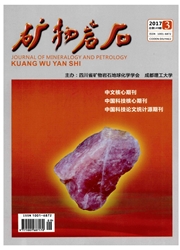

 中文摘要:
中文摘要:
浙西开化石龙头金矿是微细粒浸染型金矿床,金矿化赋存于新元古界地层的构造碎裂蚀变带中。通过光学显微镜观察以及电子探针、扫描电镜等实验测试对石龙头金矿的矿石和主要载金矿物进行测试分析,结果表明,石龙头金矿床中的主要含金矿物为黄铁矿,毒砂,其次为少量的脉石英。岩屑中的石英、白云石和粘土矿物不含金。主要载金矿物黄铁矿和毒砂的平均含金量分别为181×10-6和207×10-6。金主要以显微可见金的形式存在,其次为次显微不可见金。显微可见金主要以包裹金的形式赋存在黄铁矿晶体中或晶体边缘,次显微不可见金在黄铁矿中以纳米级金颗粒存在,在毒砂中主要以固溶体金形式存在。
 英文摘要:
英文摘要:
Shilongtou gold deposit of Kaihua in west of Zbejiang belongs to fine grained disseminated ore type. Gold mineralization occurred in tectonic fragmented alteration zone of the Neoproterozoic strata. The mineral compositions of ore rocks and major gold-bearing minerals were investigated by using petrographic observations, electron probe and scanning electron microscopy. It shows that the major gold-bearing minerals are pyrite and arsenopyrite,with minor vein quartz, whereas, gold has not been detected in quartz, dolomite and clay minerals. Anaysis reveals that average gold content of pyrite and arsenopyrite are 181 × 10^-6 and 207 × 10^-6 , respectively. Visible micrometer-size gold is dominant,with minor invisible nanometer-size gold. The former occurs in pyrite crystals or crystal edge in the form of inclusion gold grains,and the latter displays as nano particles of native gold in the pyrite and solid solution in arsenopyrite.
 同期刊论文项目
同期刊论文项目
 同项目期刊论文
同项目期刊论文
 Clay mineralogy along the laterite profile in hubei, south china: mineral evolution and evidence for
Clay mineralogy along the laterite profile in hubei, south china: mineral evolution and evidence for Clay mineralogy and geochemistry and their palaeoclimatic interpretation of the Pleistocene deposits
Clay mineralogy and geochemistry and their palaeoclimatic interpretation of the Pleistocene deposits Climatic and tectonic uplift evolution since ~7 Ma in Gyirong basin, southwestern Tibet plateau: cla
Climatic and tectonic uplift evolution since ~7 Ma in Gyirong basin, southwestern Tibet plateau: cla 期刊信息
期刊信息
